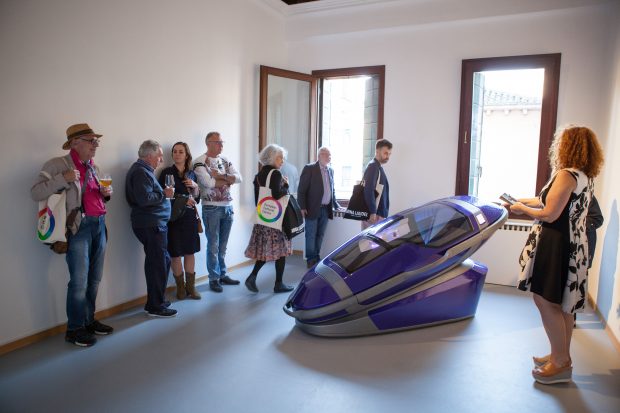July 15, 2019
The world’s leading euthanasia advocate designs a “death pod”
Philip Nitschke’s “Sarco” shines a harsh light on everything screwed up about our cultural attitude toward death.
The industrialized West doesn’t know how to deal with death. Culturally, we only seem capable of engaging with the end of a human being’s life in one way: as a problem. That problem can be “solved” by medicalizing it into a million little pieces, throwing money and fantasy at it, or simply turning away from the people facing its natural approach. Rituals of acceptance, dignity, or even beauty around death are not part of our social firmware–which is why a project like Philip Nitschke’s Sarco may seem sincere, obscene, crass, and humane all at once.
Sarco is a suicide chamber: a coffin-size pod you get into in order to painlessly and peacefully kill yourself on purpose. It’s the brainchild of Nitschke, a former physician from Australia who became an extremely vocal and active advocate of euthanasia for humans (in 1996, he became the first doctor in the world to administer a legal, voluntary lethal injection). It’s no disrespect to Nitschke’s views to describe them without mincing words: he believes that people of sound mind should be able to kill themselves if they feel they have good reasons and do so in a way that doesn’t require hiding their plans from the law or loved ones, or resorting to grotesque and unreliable DIY methods. Everybody says they want “a peaceful death,” and Sarco is a product intended to deliver that, via a strange combination of futuristic convenience and conspicuous consumption.
“There is no dignity, let alone beauty, lying on a rubber sheeted bed in an institution, hooked up to beeping machines working hard to provide us with a few more seconds of life,” Nitschke tells Co.Design via email. “The role of design is to turn something that is hitherto thought of as terrifying, and sometimes repulsive, into something that [is] nothing to be scared of, and even something that is to be embraced. A process–an experience–that is self-directed by the person, reliable (so there can be no doubt about the outcome and there is no need to worry about failure), dignified (in that there is no need to be hooked to a machine, you don’t have to undress or wear special clothing). I would also add ‘bold,’ in that a death in a Sarco will never be seen as a withering away. Rather, any person who would choose to use a Sarco is also making a very deliberate statement to the world.”
We won’t belabor the details of how Sarco gets the job done, but the short version is that it rapidly replaces the oxygen in the pod with nitrogen gas, causing a quick, painless “hypoxic death” without any of the physical panic reactions that come from being asphyxiated.
Nitschke has been called “the Elon Musk of assisted suicide,” and Sarco’s concept, created by designer Alexander Bannink, treats death with a similar swagger: it’s not a final resting place, it’s a futuristic “transport” device.
“Everything about the capsule’s design is about travel, from this world to the next (whatever that may be),” Nitschke says. The idea is that the Sarco can be transported to any setting that the “user” desires, with the large viewport in the pod offering an expansive view of something other than the “harsh lighting and dismal artwork” of hospitals and other end-of-life institutions. “I strongly believe one’s final visual outlook on the world should be of one’s choosing,” Nitschke says. “If you want the mountains, or the surf beach or the Australian outback (like I do) then the Sarco makes it possible. Take it where you want.”
He’s got a point. Whether it’s ashes being scattered into the ocean from a favorite beach, or simply a stately burial in a quiet cemetery with flowers, most of the serenity and beauty we do allow (and intentionally design) around death only happens after the person is already gone. Why shouldn’t surroundings and experiences like this be available to the person as they pass, so they can enjoy them?
Nitschke allows that “many families experience loving, caring and heartfelt deaths of their loved ones” in institutional settings like hospitals and hospices. “But everyone is always making the best of a bad lot,” he asserts. “Institutions by their very nature are not intended to be humane. While I don’t think any ever set out to be overtly inhumane, and many hospices work hard at softening that space, that is often the unintended consequence.”
But is Sarco a better alternative? Either way, you can’t buy one: you can only download the plans, which you must then use to 3D print and assemble Sarco on your own (in addition to sourcing your own liquid nitrogen). Right now, a prototype version is on display at the Venice Biennale.
Maybe that’s the point of an intentionally provocative product like this: to forcefully pose the question and force us to consider that perhaps “the way to do it”–that is, assuming that death is a problem with only one “correct” solution—is a formidable cultural obstacle unto itself.
